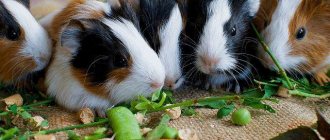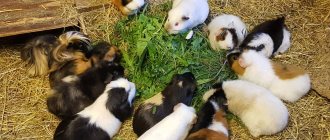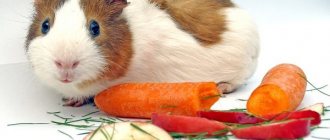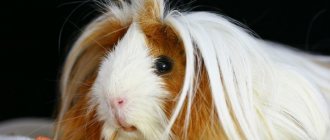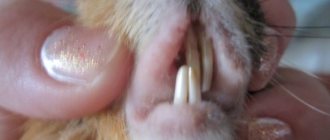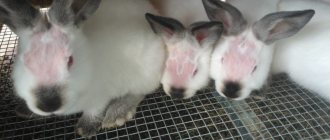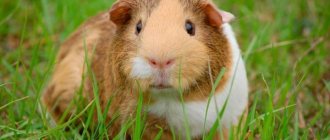- home
- Guinea pig
- Choosing and purchasing a guinea pig
02/18/2019 Keeping a pet in the house means developing a sense of responsibility and constantly having a four-legged friend at hand. Keeping an animal in an apartment for a long time was quite problematic, however, now special breeds have been bred that are ideal for such an environment.
Furry friends are often made for children, which is why they pay attention to small animals. Often there are only two options - a rabbit or a guinea pig. Who is better for a child? Who should I choose?
Maintenance and care
You can buy a long-haired guinea pig either in a nursery or through an advertisement from breeders or simply from kind people.
They reproduce amazingly in captivity, there is no shortage. Guinea pig family
The price depends on the class - pet class - from 1500 rubles, breed class - up to 2000 rubles, and show class - up to 3000 rubles. Maintenance and feed are also inexpensive.
Cell
Although this is a fairly large animal, and the pig should spend most of its time walking around the apartment, it still needs its own corner - a cage or a spacious aquarium.
Cozy corner
The choice is yours, but a couple of recommendations:
- There is no draft in the aquarium, the rodent will not chew the bars and interfere with sleep, hay and dry food will not fly in all directions;
- There is fresh air in the cage, the guinea pig can go out for walks and return independently, and it is easier to care for the home.
In a word, whatever is cheaper and easier to buy, buy it, there is no fundamental difference. Place the cage (or aquarium) in a cool place, with artificial lighting, away from strong odors and loud noises.
Bathing a rodent
Water procedures are not recommended for long-haired guinea pigs. Not only does she not need them, but they are also harmful to her silky coat. The pig still lives at home early, they do not need walks on the street, and they are able to take care of their cleanliness on their own.
If she manages to lie somewhere and needs a bubble bath, then fill a small bowl with water at room temperature, about 3 cm deep.
Water treatments
Wet only the contaminated area, lightly lather with baby shampoo, and rinse thoroughly, otherwise the animal will eat the shampoo. Make sure your head is always above the water and do not get it wet. After the bath, dry with a towel, or to be sure, dry with a hairdryer on a warm setting.
Grooming
In order for a guinea pig to have amazingly beautiful fur, as in the photo below, it will require not very complicated, but regular care.
Pig with gorgeous fur
It is worth noting right away that this procedure is very pleasant for both the animal and the person; it will only be a joy for you. The fur is very pleasant, velvety to the touch, warm, fluffy - all this calms the nerves and drives away heavy thoughts.
To get started we will need:
- Soft brush for small animals;
- A coarser wire brush;
- Manicure scissors.
They need to be combed daily, this will prevent tangles and masses of skin from appearing, which will make the fur even longer and more beautiful.
If, nevertheless, a lump has managed to appear, then it needs to be carefully cut out with scissors - it is unlikely to be possible to untangle and comb it
Curly guinea pig
Before starting the procedure, you can slightly moisten the fur - this will make it more manageable. After a couple of minutes, the fur will begin to shine, this is good, now you can lightly dry it with a hairdryer on a warm setting and feed the animal.
Guinea pigs feel their owner, they know when they bring joy to the house, and they pay back in kind.
And remember - we are responsible for those we have tamed!
Soft bag
Fabric carriers have been around for a long time, but their modern development has primarily affected the increase in the number of all kinds of windows, mesh and other little things. The cat will no longer sit in a dark bag, not much different from an ordinary travel bag. It is difficult to organize a comfortable long trip in such a device. But for short distances the convenience is quite adequate.
The advantage of a soft cage is its lightness, compactness, and the ability to securely attach it to a car seat or, for example, to the handle of a suitcase.
Negatives: Not hygienic for long trips and difficult to clean quickly (although they can withstand washing in a regular washing machine).
Cost – 1,360 – 1,489 rubles.
Feeding and caring for guinea pigs
It is not recommended to overuse cucumbers, tomatoes, apples, bananas and other fruits, because excessive consumption of these products can cause digestive problems in pigs. It is strictly forbidden to feed guinea pigs products of animal origin (eggs, cottage cheese, milk, fish, etc.). This is if you are engaged in breeding minks as a business or have established the process of breeding sable as a business, the presence of meat and fish in the diet of your wards is mandatory, and the digestive system of guinea pigs is designed in such a way that it can only process plant products and this should not be forgotten.
In general, when planning to start a business raising guinea pigs, the question of what guinea pigs eat at home needs to be carefully studied, or even better, make yourself a list of foods that can and cannot be given to rodents. Because, we emphasize once again, their digestive system is very vulnerable, and eating unwanted foods can lead to poisoning, upset or even death of the animal. Guinea pigs need to be fed twice a day - morning and evening at the same time.
And finally, one more important information - the body of guinea pigs cannot produce vitamin C. Its deficiency very often leads to animals losing appetite, weight loss, and molting. As a result, the animal becomes lethargic and motionless. To avoid these manifestations, especially in winter, guinea pigs need to add a special preparation with vitamin C to their drinking water.
Well-fed and healthy pigs love to play. Therefore, from time to time they need to be given the opportunity to frolic a little throughout the apartment (this must be done under supervision so that the animals do not get hurt or act out). If in the summer it is possible to organize a cage in the open air (in a country house, on a personal plot in a rural house), then this will only benefit the animals. The enclosure must be protected from rain and dampness, shaded from direct sunlight, to exclude the possibility of animals escaping (outside the enclosure they can die from predators). But this method of keeping (as well as short walks in the open air) is fraught with additional procedures for caring for the animals: they will have to regularly undergo deworming and thorough treatment for parasites. In general, the coats of guinea pigs, especially long-haired ones, require regular care. Therefore, among the accessories there must be a comb with rare teeth, a brush with soft bristles for combing wool. As for bathing, although pigs are marine, frequent bathing is not recommended for them. Unless they are very dirty, or it needs to be prepared for display. Here, probably, many people will have a question: how to bathe a guinea pig at home? The answer is - in warm water, using a special detergent for rodents or baby shampoo. Then everything is the same as with bathing a puppy. But that is not all. Guinea pigs have claws and they also need to be looked after, trimming them 1-2 times a month with a special claw cutter for small animals; the length of the claw, or rather its transparent part, has reached more than 2 millimeters.
If you follow all the recommendations, you can be sure that your pets will always be healthy, cheerful, and the question of how long a guinea pig lives at home will simply not arise in your mind. Although, I note, the average life expectancy in captivity is 5-7 years, and the breeder needs to know this information, at least in order to have time to prepare replacements for old breeders.
Now let's talk about the differences
First of all, the difference is manifested in the size and weight of the animals. Depending on the breed, the weight of an adult guinea pig reaches 0.7-1.2 kg, height up to 20-25 cm. Accordingly, a rabbit - 0.4-2 kg with a height of 20-50 cm. With proper care and maintenance, guinea pigs Pigs live on average 5-8 years, rabbits - 10-15 years.
Rabbits are big sleepers and can sleep up to 8 hours at a time. Guinea pigs are much more active, some individuals even prefer to sleep with their eyes open. Despite some common food preferences, our pets' diets are still different. When choosing the size of the terrarium, remember that rabbits can jump very high. Guinea pigs also jump from time to time, but not as high or as often.
Who is better, a rabbit or a guinea pig?
Of course, no one will give an exact answer to the question of who is better - this is subjective. However, the majority still lean towards overseas pets.
Guinea pigs and rabbits are similar in many ways. For example, both of them eat plant food, are not aggressive and live long.
However, according to other criteria, their content differs somewhat. The pig is a social animal and requires constant attention when kept alone. Rabbits, in turn, are quite calm and are not able to feel sad from lack of communication. If the future owner is unsure of his ability to devote a lot of time to the pet, it is better to get a rabbit.
Due to their sociality and intelligence, guinea pigs are trainable. They are also able to distinguish their name and show their love much more actively than a dwarf rabbit
Therefore, it is important to choose a creative name for your guinea pig. An equally important advantage is that there is no need for vaccinations, and there is almost no smell when the cage is regularly cleaned (while the long-eared one can emit an unpleasant odor)
Thus, if the future owner wants to get a loving animal to play with, it is better to get a guinea pig.
What do the sounds that guinea pigs make mean?
The sounds you hear from your guinea pig express his mood at the moment. ... The most common sound a guinea pig makes is a sharp whistle, which is repeated at intervals of about a second. This is a signal to greet the owner when the pig is hungry and it is time to feed. The sound is similar to "whip, whip."
Interesting materials:
How to clean windows in winter? How to clean a shoe brush? How to wash old brushes? How to saw off chipboard? How to wash fabric sneakers? How to remove stains on Eco-leather? What does a tarantula spider eat? What do wild sparrows eat? What do macaws eat? How to clean a kettle other than citric acid?
Who is better, a rabbit or a guinea pig?
Of course, no one will give an exact answer to the question of who is better - this is subjective. However, the majority still lean towards overseas pets.
Guinea pigs and rabbits are similar in many ways. For example, both of them eat plant food, are not aggressive and live long.
However, according to other criteria, their content differs somewhat. The pig is a social animal and requires constant attention when kept alone. Rabbits, in turn, are quite calm and are not able to feel sad from lack of communication. If the future owner is unsure of his ability to devote a lot of time to the pet, it is better to get a rabbit.
Due to their sociality and intelligence, guinea pigs are trainable. They are also able to distinguish their name and show their love much more actively than a dwarf rabbit
Therefore, it is important to choose a creative name for your guinea pig. An equally important advantage is that there is no need for vaccinations, and there is almost no smell when the cage is regularly cleaned (while the long-eared one can emit an unpleasant odor)
Thus, if the future owner wants to get a loving animal to play with, it is better to get a guinea pig.
Choice in favor of the child
If you are choosing a pet for a child, the choice should fall on a guinea pig. These rodents are quite easy to catch because... they are not particularly fast. You can play with them for quite a long time, they love this activity and do not get tired. They also enjoy being held and showing affection in every way possible.
The only downside is that pigs can be easily injured. Some care will be required. Otherwise, it is quite miniature and a good pet option for a child.
Although, of course, you need to listen to the child’s opinion. If your baby wants to have an “eared one” after all the explanations and explanations about the advantages of mumps, you should not refuse. Rabbits, even though they are larger and have more character, are also capable of love and make great friends.
Who will be the best pet for a child?
When deciding who is best to have at home, you should also pay attention to the character of your son or daughter. Guinea pigs are easier to care for, so if a schoolchild or preschooler is willing to spend a couple of hours a day on an animal and spend the rest of the time doing their own thing, then the clear choice is an “overseas” pig.
Article on the topic: Guinea pig allergy in children and adults: symptoms and treatment
The guinea pig is a more passive animal than the rabbit and loves to sit on hands
When a child needs a friend to whom he is ready to devote all his attention, and the parents support him and help in his care, which also unites the family, then buying a decorative rabbit can be an excellent solution. An additional bonus is that an exotic pet will interest the owner’s friends and allow him to build new social relationships.
A rabbit is larger than a guinea pig and more active
Sometimes, when thinking about whom to choose, future owners rely on such a parameter as “intelligence.” But it is necessary to understand that each animal is individual and can demonstrate completely unexpected skills, therefore, the “smarter” criterion is not always justified.
Opinions about the possibility of rabbits and pigs living together are ambivalent. In a number of literature you can find information about the safe cohabitation of the two species, however, experienced breeders recommend separating animals into cages: rabbits can harm their harmless neighbors.
For a comparison of a chinchilla and a guinea pig, read our article “Who is better: a chinchilla or a guinea pig?”
What breed of guinea pigs to choose
There are a number of questions to consider before choosing a guinea pig. Firstly, how much time are you willing to devote to your pet every day. If a little, then it is better to opt for one of the short-haired breeds: Rex, Abyssinians, Selfies. They do not require intensive care and take care of the condition of their fur on their own.
We invite you to familiarize yourself with: Hydrocortisone eye ointment - instructions for using hydrocortisone for the eyes
Secondly, how much money can you spend on buying a guinea pig? The price depends on the breed: short-haired pigs are the cheapest, long-haired ones are more expensive.
Fourthly, if there are children in the family, then again it is better to give preference to breeds whose representatives do not require intensive care. While participating in children's activities, the pig's coat will quickly get dirty. In this case, it is not advisable to purchase pigs with long hair.
Guinea pig or rabbit: which one is better to eat?
Animals at home have a positive effect on all residents, especially children
When it comes time to choose a future pet, people often focus on decorative rabbits and guinea pigs. Few people like rats, hamsters are nocturnal animals and mostly sleep during the day, cats often allow themselves too much and destroy things, not everyone can afford to keep dogs at home
In most cases, pets are bought for children, so they should be small in size. But who is better, a rabbit or a guinea pig?
Judging by the reviews, most people are leaning towards the guinea pig. She is unpretentious, eats little and has a fairly large assortment of foods. Compared to a rabbit, the stomach is stronger. If taken at an early age, it will never bite. Judging by reviews on the Internet, you can adopt one even at the age of 1-2 years, if the animal was treated well, it will not even try to bite or cause any other harm. Children really like it when the pig whistles and asks for a treat.
Parents enjoy caring for their guinea pig. It is enough to pay very little attention and that is enough. No need to walk, constantly get vaccinations. It is enough to clean the cage from time to time, feed and water it on time. One of the safest animals for children.
The disadvantages include the fact that the pig is easy to injure. Sometimes biting individuals can be caught. Basic care is needed in any situation. To avoid unnecessary odors, you need to clean the toilet every day. Once a week, general cleaning of the cage and washing of all contents is carried out.
A decorative rabbit needs more attention. Although, according to some owners, you can take an animal that will live on its own and come only for food. At the same time, some rabbits become so tame that they will constantly run after a person just to be close. Sometimes they even want to sleep in the same bed.
If you decide whether it is better to have a rabbit or a guinea pig, then the answer is obvious. A rabbit needs more care, feeding more often and in larger quantities. They are not that clean and often smell bad. It is more difficult for children to look after them, since they are rarely tame. Toilet training is much more difficult.
Who is better to have is up to you. Rabbits and guinea pigs have their pros and cons. But the vast majority lean towards mumps.
https://homjakam.ru/morskaya-svinka/vybor-i-pokupka/krolik-ili-svinkahttps://homkin.ru/morskie-svinki/priobretenie-morskih-svinok/sravnenie-s-krolikom.htmlhttps:// msvinkam.ru/vybor/krolik-ili-morskaya-svinka.html
Origin
The guinea pig originates from South America. Guinea pigs were domesticated back in pre-Inca times. About 400 years ago, the animals were brought to Europe under the name guinea pigs or guinea pigs.
The ancestor of domestic pigs was the wild guinea pig living in the mountainous regions of Chile. These animals live in burrows in families of up to 10 individuals.
These animals have a unique cute appearance and a gentle disposition. Pigs do not climb furniture or walls or swing on curtains. These animals are awake during the day and sleep at night. Pigs rarely scratch or bite; even small children can care for them.
They recognize the person who is caring for them and greet his appearance with a sharp whistle or soft grunt.
A guinea pig can be trained to come when called, respond to a name, “serve” and ring a bell.
Making a choice between a chinchilla and a guinea pig as a pet
When choosing a pet, you must not forget that you will have to take care of it for many years to come; this is not a temporary hobby. Many people have cats and dogs at home. But some need to be walked regularly, while others leave fur everywhere. In recent years, rodents have become popular as pets. They are easy to care for, no hair remains, and they don’t need to be taken outside. Often you have to choose between a chinchilla and a guinea pig. Both of these animals have their own nuances in care, advantages and disadvantages.
Other options
Another deadly “yummy” is prepared as follows. Grind up a wine cork, a natural one, not a plastic one, mix the resulting crumbs with small pieces of bread, pour vegetable oil over it all and leave it near the mink. The plug in the hamster's stomach begins to swell and he dies.
An interesting method of combating carbysh is to bury an alarm clock in the ground. Buy inexpensive battery-powered alarm clocks. The larger your area, the more alarm clocks you will need, the main thing is that they have a loud ringing sound and vibration mode. Now use one of the options.
1. Bury empty metal buckets in the ground, leaving them open. In them, put alarm clocks set for one time, one in each bucket. Cover the top with lids. Let them call without giving the rodents peace. Change batteries as needed.
2. This method is similar to the previous one. Only they bury not buckets, but closed jars with alarm clocks. There is both a plus and a minus here. The jars can be buried deeper, but it is difficult to change the batteries. You'll have to dig them out again every time.
The following poisons are purchased in stores and used.
1. "Rat Death." A very good and effective remedy, recommended by the owners for getting rid of any rodents.
2. "Warat". This effective drug is produced in the form of granules. It is laid out on the soil in spring and autumn after harvesting.
3. “MB Final”. This product in the form of a paste also helps to destroy rodents in the area.
There are many poisons. You need to try and choose the one that is suitable for your rodents.
RABBIT OR GUINEA PIG: WHOM TO CHOOSE?
If you are choosing a pet and your search has narrowed down to a rabbit and guinea pig, we will help you make your choice and analyze the potential pros and cons of keeping these wonderful animals.
First, about the similarities. Rabbits and guinea pigs have similar living conditions. They are usually kept in a terrarium or equipped cage. The dwelling must contain specially prepared filler (bedding), which must be changed frequently, since animals defecate profusely. General cleaning of the cage must be done at least once a week. In addition, the cage should be dry and warm. The comfortable temperature zone is from 10 to 25 degrees Celsius. Animals can also withstand short-term cold.
Both rabbits and guinea pigs need to chew constantly as their teeth grow quickly, so constant chewing inhibits tooth growth. Make sure there is always hay in the house. This is their main food. These animals cannot tolerate foods high in sugar, fat and calcium. Provide your pets with plenty of fresh drink, constantly renew it. Do not overfeed your animals with carrots and lettuce - contrary to misconception, you need to give them very little. Both of our “candidates” do not eat processed food.
Keep the animals themselves clean and tidy. Try to clear them of matted hair. There should be no traces of excrement on the paws.
If you are away from home, leave some dry food, hay and water for your pets.
The cost of purchasing and keeping both rabbits and guinea pigs is relatively low. Everything you need, including the animals themselves, can be purchased at a pet store, as well as through online advertisements.
The more time and attention you give to your pets, the more friendly they will be to you and treat you. Accordingly, with little attention, they will most likely be afraid of you. Keep in mind that both of them run fast. So, if you suddenly lose your pets, it is very difficult to catch them. It is not recommended to keep rabbits and guinea pigs together: both species get along very poorly with each other. But these animals are perfect for the role of pets if you have children of primary school age and older. Children, as a rule, enjoy looking after them.
Rabbit & chinchilla: choosing a pet
“Which should I get, a rabbit or a chinchilla?” This question is often asked by people who want to get a new pet. To help you make your choice, let’s now compare these charming fluffies according to the most basic parameters.
Smell and tray
The main factors of interest to a person planning to get a pet. Chinchilla doesn't smell. In the cage he chooses one corner for the toilet, washing which completely eliminates unpleasant odors from feces. When moving around the apartment, he can shit anywhere. There is a smell from the rabbit. The tray and cage will have to be washed regularly, sometimes 2 times a day. But the rabbit easily gets used to the tray, into which it runs while walking around the room.
Health and hygiene
Both rabbits and chinchillas react poorly to drafts and temperature changes, as well as loud, sharp sounds and smells. The rabbit needs to be regularly bathed, combed, and its claws trimmed. The chinchilla bathes in special sand in a special bath; no other care for its coat is required. If a rabbit gets sick, it is easier to cure - veterinarians deal with them tens of times more often than with chinchillas. In addition, there are vaccines for rabbits that help avoid many diseases.
Character and behavior
It is difficult to hold and pet a chinchilla. But unlike the affectionate rabbit in this regard, she will not become aggressive during puberty and hunting. The rabbit can be carried in your arms, stroked and scratched, the big-eared one will be delighted with this. Willingly take part in children's games and make friends with a cat or dog. Until he grows up, he will be sweet and affectionate. And then an increase in aggression is possible: the rabbit will attack, scratch, bite. The changes in the behavior of female rabbits become especially sharp.
Diet
Both species are considered problem-free in nutrition. Grass, hay, grain mixtures, fruits and berries - the animals’ diet is almost identical. There are no sharp differences in one direction or another.
Ease of maintenance and walking around the apartment
Both animal species require cages. An inexpensive standard cage is suitable for a rabbit, but a chinchilla cage requires a special one and is not cheap. Given nighttime activity, the cages are located away from the bedrooms. And while a rabbit can be trained not to make noise at night, this trick won’t work with a chinchilla. The cute creature puts on such nightly concerts that there may be complaints from neighbors. The disadvantages of a rabbit include peeled wallpaper, chewed wires, damaged furniture, and smelly urine marks. Although the chinchilla does not refuse the opportunity to sink its teeth into everything that catches its eye. In addition, it easily squeezes into the narrowest cracks, which can lead to unpredictable results.
Let's summarize: If you have the opportunity to devote a lot of free time to an animal, a rabbit is suitable for you. You can play with it and walk with it, taking it out on a harness, the rabbit can be trained - the animal easily masters simple tricks. If the absence of odor and a minimum of fuss with cleaning the cage are more important to you, get a chinchilla. Watching the jumps and games is also a pleasant pleasure. But all her walks around the apartment must be under strict control.
Subscribe
to our channel and read new articles, blogs and topics daily.
Our VKontakte and Facebook pages. There are also a lot of interesting things there!
Some images on our channel are taken from open sources, Yandex Images and social networks.
Source
We will equip the enclosure
It is better to choose a place for the pen with thick grass, without direct sunlight and strong wind. Make sure that no poisonous plants come into the area.
For rabbits, the height of the enclosure should be at least 1 m high (for a pig it is much lower, it does not jump so high) and at least 30 - 40 cm deep.
Chain-link mesh is suitable for the walls; do not forget to also secure it on the roof of the pen to protect it from birds of prey.
The enclosure must have a house for the pet
Anyone who has once owned a rabbit or guinea pig knows how animals love their homes, how important it is for them to hide
For a country enclosure, you can make a house from boards or a cardboard box so that your pet can rest.
There should always be a drinking bowl with fresh water in the enclosure. By the way, our guinea pig did not drink water, he got everything he needed with vegetables and grass.
When I bought it, the owner said that their pigs don’t drink either, and they don’t need drinking bowls. How surprised I was when I saw guinea pigs drinking water in a pet store.
No matter how much you poke yours, if you haven’t given it since childhood, then it won’t happen anymore. But my animal’s mother was still that picky person.
I didn’t drink water, as I already said, but sometimes I liked to indulge in sweet tea or tomato juice.
Mine completely turned away and was even offended! That’s true, he’ll puff himself up like a quonk, and look askance out of the corner of his eye until they remove “the devil knows what” from any of his boxes.
Our little pig lived not in a cage, but in a large cardboard box, a real penthouse when compared to human housing.
Love for chinchillas forever
Many people choose to keep chinchillas at home, and these animals usually live from 6 to 10 years. They are very friendly and active, so it is better to house them in spacious metal cages with a plastic tray and various devices for an active life. During the day they prefer to rest, falling asleep, and in the evening they lead a hectic life. They rustle with various objects that are in the cage, but you can quickly get used to the sounds of activity they make.
Chinchillas are excellent companions for people of all ages, especially children, and can be kept alone. However, they are very sociable animals and live well in pairs. Having started a family of these rodents, you will be able to observe interesting scenes of family life. Basically, they always accept the second animal well, and later they frolic together and run around the cage, although most often the female chases the male when he shows his courtship towards her. They either make noise and run around the cage, sorting things out, or they sit next to each other and gently stroke each other.
Chinchillas need a varied diet. This includes vitamin-enriched food and grass, vegetables and nuts, dry and fresh fruits, hay, and they also have an interest in human food. There should always be a drinking bowl with fresh water in the cage. Animals also love water treatments, so put a bathing suit in their house. Usually it is put on for a couple of hours every day, without leaving it on all the time.
Experts name several advantages of keeping chinchillas in your home:
- get along well with people and other pets; simple care suits them; become tame and amenable to training; practically do not bite and do not show aggression; have a fairly long life (in some cases they live up to 20 years); rarely get sick; do not have an unpleasant animal odor; very beautiful, funny and fluffy animals with an interesting character.
By the way, do you know how to give vitamins to a chinchilla? Look, it's interesting!
In favor of the guinea pig
Many people prefer guinea pigs. Cheerful and kind animals that get along easily with children and adults. Care depends on the character, some individuals are completely autonomous and do not require interference in their personal life. During this time, you need to make time for others and play with them. In any case, you need to allocate funds for housing. Although the guinea pig is very calm by nature, in some circumstances it may bite, although it does not hurt. The character of a rodent is revealed; it can chew furniture and interior items. Although this situation only occurs in the absence of mineral stone, the animal simply needs to grind down its constantly growing teeth. The guinea pig is quite cautious around people.
Like the chinchilla, the guinea pig loves space and therefore requires a large cage. To save money, they often do it themselves. Inside there should be everything you need: a feeder, a drinking bowl, a house and other accessories. To avoid unnecessary odors, you need to buy and install a special toilet, which is cleaned once a day. There must be bedding. The diet needs to be varied and should include greens and solid food that can grind teeth. The pig should also eat vegetables, fruits, grains, grass, tree branches and vitamin complexes.
The guinea pig is smart and has a good memory. Able to recognize its owner and other people. She can be toilet trained and given a nickname. You need to look where the animal goes to relieve itself and place the tray there. There is a whole article about this: how to toilet train a pig. Some people give up on this cute animal because of the unpleasant smell. Not everyone understands how to train a pet and avoid odor problems.
Reviews differ regarding sociability. Some emphasize the autonomy of the pig, that it does not need a person, it just needs to be fed on time. Others at this time claim that without them she makes noise and constantly wants attention and affection. Perhaps it all depends on the upbringing and the number of individuals in one house.
https://youtube.com/watch?v=IfC29ixPdYE
Compared to a chinchilla, a guinea pig is much more susceptible to disease. It can quickly blow out in a draft; you need to watch this and choose a quiet place to place the cage. Most often, diseases affect the digestive system and respiratory tract. Vitamin deficiency can occur just as often if there is no proper nutrition. To prevent this, you need to regularly clean the cage and provide adequate nutrition. By nature, the guinea pig is very active, it is recommended to regularly take it for walks, at least around the apartment.
There are several advantages to keeping a guinea pig:
- We do not require much care;
- Absence of any allergic reactions to them;
- Cheerful and sociable animals;
- Positive and good-natured;
- They eat little;
- They sleep at night, peak activity occurs during the day;
- They love human affection.
The guinea pig gets used to the new environment very quickly. Almost never bites and there is no aggression at all. He quickly runs away from anything he considers dangerous. Loves company, if there are no other animals, the only friend becomes a person. In this case, you need to devote much more of your time to her.
Advantages and disadvantages of chinchillas
Chinchillas are very cute-looking rodents. Their maintenance does not cause much trouble. And with the right approach, you can establish a close psycho-emotional connection with your furry pet. At the same time, these cute animals have many advantages:
- Their fur is hypoallergenic , so people suffering from allergic reactions can easily get them.
- They do not have sweat glands . Accordingly, there is no unpleasant odor coming from the cage with the pet.
- Chinchillas rarely get sick , so under the right conditions they can easily live to a ripe old age.
- No need for company . A chinchilla can independently find ideas for spending time. In addition, the fluffy dog does not require the attention of the owner.
- No shedding . Despite the fluffy coat, the animals’ hair practically does not fall out. Therefore, the pet does not bother the owner with frequent cleaning of the apartment.
- Diverse breed composition . Breeders have bred more than 20 varieties of chinchillas. So, everyone can choose a pet to their liking.
- High level of intelligence . Chinchillas are smart, they respond to their names and can be taught simple tricks.
Cute animals are not without their shortcomings. Fortunately, there are not many of them. The main disadvantages of chinchillas include:
- Complex nature . The animal cannot be picked up without permission. The pet loves solitude and prefers not to be disturbed again. Otherwise, he may harbor a grudge.
- Nocturnal lifestyle . The pet will inevitably make noise at night and wake up everyone in the household.
- Sensitivity to environmental conditions . Chinchillas naturally live in cold mountain climates. Therefore, when keeping an animal, it is necessary to maintain a cool temperature at home - within +18-20ᵒС. Fluffies feel especially uncomfortable in the summer.
- Food sensitivity . A chinchilla can only be fed with specialized food and several additional natural foods (fruits, vegetables, nuts, cereals, berries, seeds). At the slightest deviation from the diet, the pet’s well-being deteriorates sharply.
At the same time, it is very difficult to obtain qualified medical care for a chinchilla. The fact is that these rodents are very specific, and only specialists with a narrow focus can handle their treatment. It is especially difficult to find a professional veterinarian in remote cities.
When organizing feeding a chinchilla, you should not change specialized formulations too often. If you suddenly switch to even super-premium food, your pet’s health may deteriorate.
Pros and cons of keeping at home
Arguments for"
Of course, the advantage of these pets is their cute and pleasant appearance. A variety of breeds allows future owners to choose an animal according to individual preferences. In addition, there are additional arguments in favor of buying an animal:
- keeping in a confined space, enclosure or cage;
- unpretentiousness;
- simple diet;
- quite peaceful character;
- satisfactory health and not the shortest age.
If the rules of care and maintenance are followed, the average lifespan is 7-8 years. Sometimes decorative specimens live 10 - 13 years in indoor conditions.
Arguments against"
Keeping a rabbit in the house has its disadvantages:
- with a free lifestyle, the animals gnaw everything that comes into contact with their teeth, with a particular passion for electrical wires;
- If you make mistakes in cleaning the cage, then a smell quickly appears, and irritation from urine appears on the animal’s skin;
- these animals are not suitable for allergy sufferers, rabbit biological products cause allergy attacks;
- The digestion of rabbits is designed in such a way that they have a need to eat feces.
- It is difficult to form toilet behavior; very often it is impossible to train to the toilet.
Hamster and chinchilla
The significant difference in size and character traits of both animals precludes their coexistence in the same dwelling. First of all, chinchillas require a very large cage, completely unsuitable for hamsters. Both species can be aggressive, and if the chinchilla is only slightly harmed, the small rodent can be eaten by a larger animal.
A hamster's diet often includes fresh pieces of vegetables and fruits, but for chinchillas, raw food is contraindicated, so pets should be kept separately from each other.
Caring for your pig
At first the pig will be afraid of everything, during this period of adaptation just try not to notice the animal
Excessive attention to yourself will only frighten the guinea pig even more. But this is only the first couple of days until she gets used to the new home and understands that her life is not in danger
After getting used to it, on the contrary, under no circumstances leave the animal to its own devices, be sure to play with it, teach it tricks, communicate - this is a social animal that can become wild and embittered.
The pig must be tame
Be sure to give the animal a name. Guinea pigs have a fairly developed brain and intelligence, they are able to learn simple tricks, and it couldn’t be easier for them to respond to their name.
Water treatments
Guinea pigs, contrary to their name, do not like water. You should only take a bath if necessary, if the animal has been rolling around in the mud. Better yet, watch the video:
After a bath, be sure to dry it with a towel, otherwise the animal will catch a cold in the draft. You shouldn't use a hairdryer either.
Animal diseases
Since we mentioned diseases, let us present the painful state of mumps:
- Lethargy, reluctance to move;
- Squinted or often completely closed eyes;
- Arrhythmic breathing, cough or wheezing;
- Thirst;
- Externally unhealthy coat, easily plucked;
- Discharge on the eyes and nose;
- Minor trembling in the body;
- Frequent bowel movements, diarrhea;
- Convulsions;
- Parasites.
Self-medication is unacceptable; antibiotics can only be prescribed by an experienced doctor. Although this may turn out to be a banal allergy to food, you shouldn’t hope for it.
A sick animal will begin to seek solitude to rest, will stop making characteristic sounds when meeting its owner, and will generally begin to behave atypically. Keep an eye on this.
Nutrition
In order for your family friend to have good immunity, proper nutrition is necessary. There are 2 types of food - natural and ready-made.
Natural ones include:
- Hay;
- Lettuce, cabbage;
- Fruits;
- Various herbs.
Don't offer your pig raw potatoes. Feeding should be 2-3 times a day; constant eating of hay is not considered feeding.
Be sure to regularly include ready-made fortified foods, which are sold in any pet store, in their diet.
Ready food
Their granules contain barley, vitamins, alfalfa, minerals - everything that is necessary for a healthy and fulfilling life for a furry cat.
Hay is necessary for grinding down the incisors; do not forget to add it as needed. You can, of course, put a mineral salt stone, but this is not a strict rule.
Of course, if you don’t like this, you can immediately clean up after your pig; with the current food, they get everything they need even in one meal.
Drinking fountain
Such a device can serve not only to quench the thirst of animals, but also become an original accent in the home interior. The design consists of a water bowl, a filter, a diffuser and a drinking bowl located at the top. Additionally, it is equipped with a decorative sprinkler, especially popular with native breeds (Maine Coons, Kuril Bobtails, Siberian cats).
Continuous circulation of liquid is ensured by a mini-pump powered by a USB cable. More advanced models may contain backlighting and an indication of the level of remaining water in the tank.
Cost – 2400 rub.


